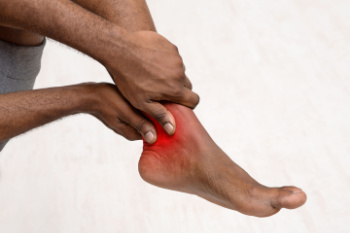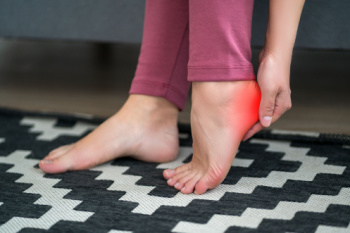
Psoriatic arthritis, or PsA, is a condition intricately linked with psoriasis, affecting up to 50 percent of those individuals with PsA. Psoriatic arthritis targets the joints, tendons, and ligaments of the feet, leading to inflammation and discomfort. Symptoms can include swelling, pain, stiffness, and changes in appearance, such as nail pitting and skin lesions. Foot involvement in PsA can make walking and daily activities challenging, with conditions like plantar fasciitis and Achilles tendonitis causing significant pain and limiting movement. Complications like dactylitis, which is a sausage-like swelling of the toes, and arthritis mutilans, or joint deformity, can occur if left untreated. Podiatrists can offer tailored treatment plans, including medication and specific orthotics to alleviate symptoms and enhance mobility. If you believe you have psoriatic arthritis that is affecting your feet, it is suggested that you schedule an appointment with a podiatrist.
Arthritis can be a difficult condition to live with. If you are seeking treatment, contact Dean Kim, DPM from Greater Texas Foot & Ankle Specialist. Our doctor can provide the care you need to keep you pain-free and on your feet.
Arthritic Foot Care
Arthritis is a term that is commonly used to describe joint pain. The condition itself can occur to anyone of any age, race, or gender, and there are over 100 types of it. Nevertheless, arthritis is more commonly found in women compared to men, and it is also more prevalent in those who are overweight. The causes of arthritis vary depending on which type of arthritis you have. Osteoarthritis for example, is often caused by injury, while rheumatoid arthritis is caused by a misdirected immune system.
Symptoms
- Swelling
- Pain
- Stiffness
- Decreased Range of Motion
Arthritic symptoms range in severity, and they may come and go. Some symptoms stay the same for several years but could potentially get worse with time. Severe cases of arthritis can prevent its sufferers from performing daily activities and make walking difficult.
Risk Factors
- Occupation – Occupations requiring repetitive knee movements have been linked to osteoarthritis
- Obesity – Excess weight can contribute to osteoarthritis development
- Infection – Microbial agents can infect the joints and trigger arthritis
- Joint Injuries – Damage to joints may lead to osteoarthritis
- Age – Risk increases with age
- Gender –Most types are more common in women
- Genetics – Arthritis can be hereditary
If you suspect your arthritis is affecting your feet, it is crucial that you see a podiatrist immediately. Your doctor will be able to address your specific case and help you decide which treatment method is best for you.
If you have any questions, please feel free to contact our office located in Frisco, TX . We offer the newest diagnostic and treatment technologies for all your foot care needs.




 Tarsal tunnel syndrome
Tarsal tunnel syndrome




